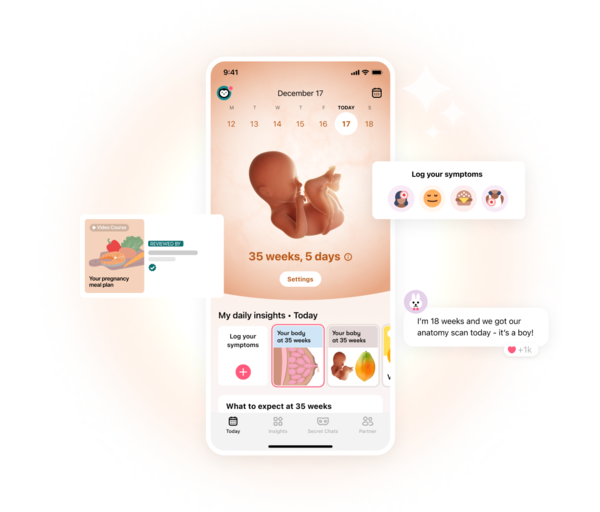Decorating the nursery for your baby’s arrival can be very exciting for new parents. But can you paint when pregnant? The good news is, painting while pregnant isn’t necessarily a forbidden activity. You just have to know the risks and choose paint types carefully.
-
Tracking cycle
-
Getting pregnant
-
Pregnancy
-
Help Center
-
Flo for Partners
-
Anonymous Mode
-
Flo app reviews
-
Flo Premium New
-
Secret Chats New
-
Symptom Checker New
-
Your cycle
-
Health 360°
-
Getting pregnant
-
Pregnancy
-
Being a mom
-
LGBTQ+
-
Quizzes
-
Ovulation calculator
-
hCG calculator
-
Pregnancy test calculator
-
Menstrual cycle calculator
-
Period calculator
-
Implantation calculator
-
Pregnancy weeks to months calculator
-
Pregnancy due date calculator
-
IVF and FET due date calculator
-
Due date calculator by ultrasound
-
Medical Affairs
-
Science & Research
-
Pass It On Project New
-
Privacy Portal
-
Press Center
-
Flo Accuracy
-
Careers
-
Contact Us
Is Painting While Pregnant Safe?


Every piece of content at Flo Health adheres to the highest editorial standards for language, style, and medical accuracy. To learn what we do to deliver the best health and lifestyle insights to you, check out our content review principles.
What are the risks of painting while pregnant?
There isn’t a lot of data on this matter, since research would involve exposing pregnant women to different substances and assessing the outcome.
The question about paint being potentially unsafe has to do with the fumes that paint produces and the chemicals that are used to make it. Paint is full of chemicals, and the effects they have on unborn children are still unknown.
Volatile organic compounds, or VOCs, are common chemical compounds that naturally evaporate under normal, indoor environments. Scientists have found that exposure to VOCs can cause significant harm to adults and children outside of the womb. Fumes from these VOCs, which are present in most paints, can result in anything from nausea and mild dizziness to severe damage to the liver, central nervous system, and kidneys.
This is why many paint manufacturers advise keeping an indoor room well ventilated while you paint.
Paints to avoid during pregnancy
If you’ve decided you want to paint the nursery, there are some paints and painting-related activities you should avoid.
- Avoid solvent-based paints. Many decades ago, this was the only type of paint available. It’s more commonly designated as “oil-based.” These types of paints give off high levels of VOCs and should definitely be avoided if you’re pregnant. Symptoms of exposure to these paint vapors include headaches, eye irritation, fatigue, nausea, and dizziness.
- Don’t use paints that contain the solvent toluene. Pregnant women who breathed large amounts of toluene in order to get high have had children with birth defects, including mental and growth delays.
- Avoid lead-based paints. This type of paint is no longer sold, but it may be present in older houses that haven’t been renovated in a while. If you’re pregnant, avoid stripping old paint.
Pregnancy-friendly paints
- Water-based paints are generally considered to be safer than oil-based paints, which contain harsh solvents and other chemicals. Acrylic or latex paint is water based. However, some water-based paints still contain certain solvents, which can present potential risks for expectant mothers. Don’t purchase paints that contain ethers, biocides, or ethylene glycol. These are ingredients found in some latex and acrylic paints.
- Zero-VOC paints are generally considered the safest option for pregnant women to use, and you can find many paints like this on the market. However, it’s still important to be careful, because while some paint bases may be free of VOCs, any color pigments added by the hardware store after you pick out the base may contain VOCs.
Take a quiz
Find out what you can do with our Health Assistant
Safety precautions for painting during pregnancy
Just as many people say that the safest birth control method is abstinence, when it comes to painting, the safest choice for soon-to-be moms is to avoid it altogether. Instead, you can make it a project for your partner, relative, or friend.
Just as many people say that the safest birth control method is abstinence, when it comes to painting, the safest choice for soon-to-be moms is to avoid it altogether.
If you have decided to paint during pregnancy, make sure you take these important precautions.
- Pick the right time. Try not to paint during your first trimester because the potential risks to your baby are greatest during the first 13 weeks, when their organs are beginning to develop.
- Cover your skin. Wear long pants, a long-sleeved shirt, socks, shoes, and gloves to keep paint off your skin. In case of an accidental splatter, wash the affected area with soap and warm water.
- Wear a mask. While you’re picking up your paint at the hardware store, make sure to pick up a mask or respirator, which shields you from breathing in paint fumes. Make sure the one you select is approved by the National Institute for Occupational Safety and Health. The packaging should indicate this.
- Provide good air ventilation. Open windows in the room — even if it’s cold outside — to ensure fumes can escape and allow fresh air to enter. If it’s a warm day, you can use box fans to help fumes escape.
- Don’t strip old paint. Even though you don’t have to worry about lead in new paint, if you live in an older house, there may be some traces of it on the walls. Have someone else prep the walls if the paint is old.
- Avoid eating and drinking. Don’t eat or drink in the same room you’re painting in. Instead, take breaks and keep water or food somewhere else. Otherwise, you risk your food becoming contaminated.
- Keep your balance. Pregnant women aren’t exactly dexterous and nimble on their feet, which is another reason why painting isn’t recommended while pregnant. While you’re sporting your baby bump, your center of gravity shifts, so don’t climb a ladder to paint up high. Have someone else tackle those hard-to-reach wall areas.
- Clean up. When the project is complete, it’s a good idea to wash up and take a shower to help get rid of any lingering paint fumes or drops on your skin.
The bottom line
So, is it safe to paint while pregnant? While studies have shown that the likelihood of harming your fetus while using water-based or zero-VOC paints is extremely low, it’s still important to take preventive safety measures before you tackle painting the nursery.
Studies have shown that the likelihood of harming your fetus while using water-based or zero-VOC paints is extremely low.
If you’d rather play it safe, there’s nothing wrong with letting someone else handle the painting. That frees you up to find the perfect wall border, stencils, or decals to enhance your baby’s new room.


Hey, I'm Anique
I started using Flo app to track my period and ovulation because we wanted to have a baby.


The Flo app helped me learn about my body and spot ovulation signs during our conception journey.


I vividly
remember the day
that we switched
Flo into
Pregnancy Mode — it was
such a special
moment.
Real stories, real results
Learn how the Flo app became an amazing cheerleader for us on our conception journey.
References
History of updates
Current version (04 November 2019)
Published (21 October 2019)
In this article

Get your personal guide to pregnancy with the Flo app
-
Follow your baby's growth week by week
-
Get expert info on symptoms, safe foods, and more
-
Chat with other parents-to-be




